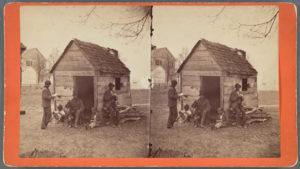As Harper would write in a letter published by William Still in his revised Underground Rail Road Records (1883), “a room to myself is a luxury that I do not always enjoy.” Armed with her book, glasses, and a room of her “own,” Aunt Chloe models a world in which material security does not hamper Black women’s intellectual pursuits. In the poem’s final image, she reads her Bible in her “little cabin,” enjoying the stability and privacy previously denied Uncle Caldwell in his own quest to read. If Uncle Caldwell’s hat-concealed pages register the scarcity and trickster strategies that characterize reading under slavery, Aunt Chloe’s bound Bible projects a desired reading future in which she no longer must hide but can lay claim to her place at the table.
Further Reading:
For a comprehensive introduction to Harper and her writings, see Frances Ellen Watkins Harper, A Brighter Coming Day: A Frances Ellen Watkins Harper Reader, ed. Frances Smith Foster (New York: Feminist Press at the City University of New York, 1990). Other primary sources referenced in this article include Frederick Douglass, My Bondage and My Freedom (1855), republished in Henry Louis Gates Jr., ed., Douglass Autobiographies (New York: Library of America, 1994), passage quoted on p. 224; William Wells Brown, “Narrative of the Life and Escape of William Wells Brown” (1853), republished in M. Guilia Fabi, ed., Clotel; or, The President’s Daughter (New York: Penguin, 2004), passage quoted on p. 22; Samson Occom, “A Short Narrative of My Life” (1768), republished in Carla Mulford, ed., Early American Writings (New York: Oxford University Press, 2002), passage quoted on p. 870; “North Carolina,” The American Missionary 11 (Sept. 1867): 194-95; William Still, Still’s Underground Rail Road Records (Philadelphia: William Still, 1883), passage quoted on p. 777. Digitized copies of Frederick Douglass’ Paper can be accessed via the Library of Congress.
On Frances Harper’s relationship with varied print formats, see Meredith McGill, “Frances Ellen Watkins Harper and the Circuits of Abolitionist Poetry,” in Early African American Print Culture, ed. Lara Langer Cohen and Jordan Alexander Stein (Philadelphia: University of Pennsylvania Press in Cooperation with the Library Company of Philadelphia, 2012), 53-74 (see especially 62). For other critical treatments of “Learning to Read,” see Melba Joyce Boyd, Discarded Legacy: Politics and Poetics in the Life of Frances E.W. Harper, 1825-1911 (Detroit: Wayne State University Press, 1994), 163-64.
On the book as “antiblack object,” see Beth A. McCoy and Jasmine Y. Montgomery, “Dionne Brand’s A Map to the Door of No Return and the Antiblackness of the Book as an Object,” in Against a Sharp White Background: Infrastructures of African American Print, ed. Brigitte Fielder and Jonathan Senchyne (University of Wisconsin Pres, 2019), 131-46. On the relationship between African American literature and unbound print, see P. Gabrielle Foreman, “The Christian Recorder, Broken Families, and Educated Nations in Julia C. Collins’s Civil War Novel The Curse of Caste,” African American Review 40 (Winter 2006): 705-16; Eric Gardner, Black Print Unbound: The Christian Recorder, African American Literature, and Periodical Culture (New York: Oxford University Press, 2015); and Michaël Roy, “The Slave Narrative Unbound,” in Against a Sharp White Background, 259-76.
On the ways nineteenth-century Black activists fostered their own schooling networks and advanced education during and after the Civil War, see Hilary Green, Educational Reconstruction: African American Schools in the Urban South, 1865-1890 (New York: Fordham University Press, 2016); and Kabria Baumgartner, In Pursuit of Knowledge: Black Women and Educational Activism in Antebellum America (New York: New York University Press, 2019), whose concept of “purposeful womanhood” offers a generative frame for interpreting Aunt Chloe’s knowledge seeking activities. On alternative ways of knowing and modes of literacy acquisition practiced by enslaved people, including eavesdropping and “stealing” an education, see Heather Andrea Williams, Self-Taught: African American Education in Slavery and Freedom (Chapel Hill: University of North Carolina Press, 2005).
Other important critical work on nineteenth-century African American print culture that has informed my thinking here includes Frances Smith Foster, “A Narrative of the Interesting Origins and (Somewhat) Surprising Developments of African-American Print Culture,” American Literary History 17 (Winter 2005): 714-40; Carla L. Peterson, Doers of the Word: African-American Women Speakers and Writers in the North (1830-1880) (New Brunswick: Rutgers University Press, 1998); Elizabeth McHenry, Forgotten Readers: Recovering the Lost History of African American Literary Societies (Durham: Duke University Press, 2002); and Derrick Spires, The Practice of Citizenship: Black Politics and Print Culture in the Early United States (Philadelphia: University of Pennsylvania Press, 2019).
This article originally appeared in December 2021.
Madeline Zehnder is a Postdoctoral researcher at Humboldt University of Berlin. She received her PhD from the University of Virginia. Her book project, tentatively titled Made to Move: Pocket-Sized Print and its Uses in Nineteenth-Century America, investigates the role of format in shaping diverse print cultures of the nineteenth-century United States.
























